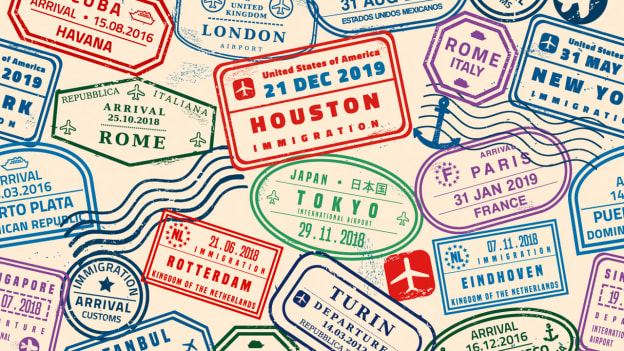Status of immigrant workers: A global mobility perspective

With the War for Talent getting fiercer, companies are facing new challenges in getting the right talent in the right role in the right place and at the right time. With the world becoming smaller and boundaryless, Global Mobility is being hailed as the go-to strategy to achieve this. The ability to move talent across geographies also unveils the opportunity for engaging, developing and retaining talent. Global mobility demands a whole new talent outlook within the top echelons of organizational leadership. Moreover, it is greatly influenced by economic, political, social environments of different nations. Global Mobility and HR practitioners must, therefore, keep abreast of the macro-changes that impact talent mobility. Here is a round-up of how global mobility and immigration changes panned out for 2019.
In 2020, global employers are likely to face heightened hurdles to hiring foreign labour, such as stringent compliance, making Talent Acquisition a highly strategic endeavour.
Immigration changes taken place in 2019: A list
UK and Brexit impact:
While the Brexit deadline has been extended till 31 Jan 2020, the proposed exit of UK from the EU shall have significant impact on immigration within the EU. The proposed changes to the Tier 2 Sponsor Licence and Tier 2 visa scheme should benefit many employers and UK visa migrants. The most notable changes will occur across the Tier 2 (General) visa category, the UK Start-up and Innovator visa schemes, the Tier 1 Exceptional Talent visa route and the EU Settlement Scheme. Going ahead, UK companies are expected to increase sponsorship for skilled, non-European Economic Area (EEA) nationals for job roles in Britain.
Europe and its mixed approach:
Rising minimum wages are a European talent norm, and have often been a hindrance for employers. Annual increases of up to 10 percent remained a trend in 2019, and are likely to continue. Some restrictive practices continued- Switzerland eliminated the Work and Residence Permit quotas for Bulgarian and Romanian nationals, and Czechia and Poland too reduced inflow. Other countries welcomed global workers- Croatia almost doubled the quota from 2018, while Romania offered 5000 more work authorization spots.
USA and Trump nationalism:
Activity is rife with respect to President Trump’s decision to end the popular Obama-era immigration program, a fallout being increased requests for evidence (RFE) and denials. RFE rates for H-1B petitions have nearly doubled from FY 2015 to the first half of FY 2019. With heightened scrutiny and delays, processing times have slow down under Trump’s “Buy American, Hire American” executive order. Going ahead too, we can expect heightened eligibility criteria, for H1B and B1 business visitors. Interestingly, this restrictive approach has not dampened foreign worker demand- employer requests for H1B workers increased more than 5 percent in 2019. The US Citizen and Immigration Services may implement a new H1B cap system in early 2020, and may propose to rescind work authorization for H4 spouses of H1B employees.
Canada and the Global Talent Stream:
Canada’s March 2019 budget included an ongoing allocation to establish the successful Global Skills Strategy and Global Talent Stream as permanent fixtures of the Canadian immigration system. In fact, the fast-tracked route for Temporary Foreign Worker (TFW) visas has spurred significate economic growth, and also gained popularity with corporations and highly skilled foreign talent. It truly seems to have gained a status of permanency. Yet, setbacks are seen in pockets. On the contrary, the Quebec government had announced a goal to reduce immigration by 20 percent through a bill that would overhaul the Regular Skilled Worker Program, making it harder for English-speaking foreign nationals in the region.
Latin Americas and Political Will:
LATAM: Especially in the technology sector, LATAM countries like Brazil, Chile and Argentina and Panama have relaxed immigration norms. Chile’s public StartUp accelerator program encourages foreign nationals to invest and institutionalise new companies. Argentina, Panama and Chile have also relaxed visa requirements for Indian nationals, to encourage flow of technology talent and cultural mixing. In fact, in Feb 2019, Argentina was selected as a hub for transferring innovation and technology from India. Yet, protection of local labour is seen in pockets. In Columbia, a new immigration law is likely to enforce higher education and skills standards for locals, encouraging local employment. Similarly, Panama immigrations laws passed in June 2019 promote the hiring of local personnel by start-ups and small companies. Mexico and Venezuela are seeing processing delays due to inefficiencies driven by political and economic changes, such as the restructuring of the National Immigration Institute (INM) of Mexico.
APAC and dual approach:
Singapore is an already tight immigration market. In March, the Ministry of Manpower announced upcoming changes to make it harder for companies to employ foreign workers over local workers. The Local Qualifying Salary was increased by SGD 100 per month for companies in all sectors, forcing companies to raise local salaries in order to recruit more foreign workers. Singapore also decreased Work Permit and S Pass quota entitlements and allocations. Australia seems to be an exception, the current liberal immigration policy remains unchanged, and Australia will continue to attract immigrants to its rural areas through its Global Talent Scheme. Japan and Indonesia too are enforcing immigration-friendly policies, while Philippines and Thailand are restrictive due to the security-related concerns faced by them, from immigrant populations. These trends shall continue into 2020.
Middle East and UAE VISAs:
Early in 2019, the UAE cabinet approved the regulatory framework for five- and ten-year visas for special talents, investors, entrepreneurs, and outstanding students, and also passed new permanent residency “Golden Cards”. Saudi Arabia too, has conceptualized a new greencard-like special residence scheme, aimed at welcoming affluent and highly-skilled foreign nationals. However, in 2020 we may see some protectionist means due to the sustained economic downturn in some countries such as Saudi Arabia.
Africas and their conservative stance:
Governments have implemented protective policies for domestic and regional labour markets. In 2020, the trend is expected to continue, with governments mandating training and succession planning. Africas are building tech infrastructure to propel these changes.
Impact on Organization: How companies must navigate in 2020
HR and business leaders must start by thoroughly understanding the organizational presence in accordance with the business strategy- existing markets, potential markets and depleting markets. They must assess the country-wise impact of the changing immigration norms, and devise a highly country or region-specific talent strategy. The talent strategy must address key concerns such as skilled and unskilled labour availability, costs of immigrant workers versus local labour, expat and global mobility costs, future political (and thereby talent) predictions, legal considerations as per labour law, impact of digitalization on workforce and the opportunity and impact of digitizing jobs etc. HR must also think from the employees’ perspective. Global mobility is a great tool to attract, engage, develop and retain top talent, especially millennials. It provides opportunities for cross-cultural exposure, challenging work and leadership opportunities for middle-rung managers. Not to mention, better productivity due to a better engaged, and the cost impact. The time is now for HR to become mobility-advisors to the CXO-suite, guiding them on the right talent-mobility decisions to support a growing global business.

















